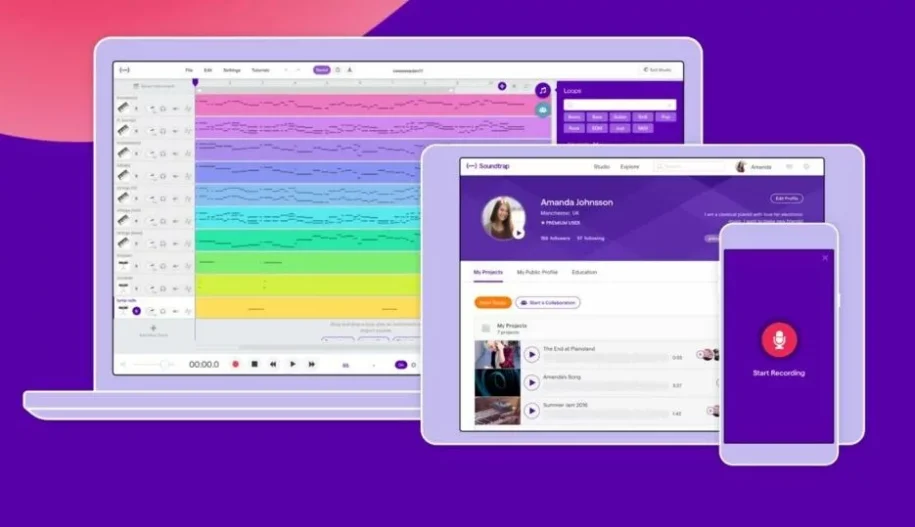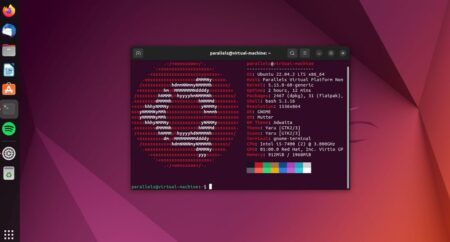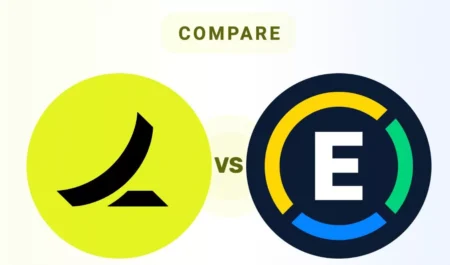1
Soundtrap and Audacity are popular pieces of software for editing audio, and each has a distinct set of capabilities that are tailored to meet the requirements of a specific user. Soundtrap is a digital audio workstation (DAW) that is hosted in the cloud and provides capabilities such as collaborative tools, a massive collection of loops, and accessibility across multiple platforms.
Audacity, on the other hand, is a desktop-based software that is open-source and is well-known for its ease of use and vast editing features. While Soundtrap is exceptional when it comes to accessibility and collaborative work, Audacity shines out due to the comprehensive editing functions it offers and the freedom it provides. Musicians, podcasters, and audio fans frequently choose one of these two options since they each provide their own unique set of benefits, which vary according to the interests and needs of the user.
Soundtrap vs Audacity Comparison Table
Soundtrap’s cloud-based platform focuses on accessibility and collaboration, making it appealing to people who want a simple way to handle projects. Audacity focuses on providing advanced audio editing features, which attracts experienced users who want to have complete control over their projects.
| Feature | Soundtrap | Audacity |
|---|---|---|
| Multi-track recording | Yes | Yes |
| Real-time effects | Yes | No |
| Automated mixing | Yes | No |
| Waveform editing | Limited | Yes |
| Noise reduction | Limited | Yes |
| Custom audio effects | Limited | Yes |
| Download Now | Download Now |
Soundtrap vs Audacity: Ease of Use Comparison
The user interface of Soundtrap is designed to be intuitive and user-friendly, with drag-and-drop capability that is suitable for both novices and experienced users. Its platform, which is hosted in the cloud, makes seamless collaboration and project management possible, thereby improving the efficiency of workflow. The interface of Audacity, on the other hand, is more sophisticated, which means that it requires a steeper learning curve for novice users.
On the other hand, its sophisticated editing features provide exact control over the audio, which is preferred by people with more skill. In contrast to Soundtrap, which places a greater emphasis on accessibility and collaboration, Audacity specialises in granular audio modification, making it perfect for individuals who are looking for extensive editing skills despite the fact that it is initially complicated.
Soundtrap vs Audacity: Audio Editing Tools and Effects Comparison
A wide variety of audio editing tools are available with Soundtrap. These features include the ability to record many tracks simultaneously, to apply effects in real time, and to perform automated mixing. The intuitive design of its interface makes it possible to create and collaborate on a wide variety of audio projects without any difficulty. Audacity, on the other hand, offers a comprehensive collection of editing features, such as the ability to manipulate waveforms, reduce noise, and create audio effects that may be customised.
It is designed to provide fine control and manipulation of audio, making it appealing to individuals who are looking for granular adjustments. Both systems are designed to meet the diverse requirements of their users. Soundtrap excels in its ability to facilitate collaborative and user-friendly processes, whilst Audacity shines in its ability to provide audio editing enthusiasts with intricate control and customisation possibilities.
Soundtrap vs Audacity: Multi-Platform Compatibility vs Desktop Software:

The cloud-based platform that Soundtrap offers ensures interoperability across several platforms and can be accessed on devices running Windows, macOS, iOS, and Android. This capability makes it possible to access projects and collaborate on them from any location as long as there is internet availability. On the other hand, Audacity is only compatible with desktop computers and is only compatible with Windows, macOS, and Linux operating systems. This means that it is only accessible on certain devices.
Audacity’s desktop-bound structure delivers comprehensive functionality but confines users to designated operating systems, potentially limiting flexibility for individuals who want mobility or diversified platform usage. Soundtrap, on the other hand, prioritises universal access and collaborative capabilities when it comes to its capabilities.
Soundtrap vs Audacity: User Interface Comparison
Soundtrap’s user interface is streamlined and easy to use, including a contemporary style and straightforward controls that make navigation a breeze. Its drag-and-drop functionality makes the process of composing and arranging music more efficient. The numerous menus in Audacity may give the impression that the programme is overly complicated. The layout, on the other hand, provides fine control over audio editing, which is preferred by more experienced users for more advanced customisation.
Audacity caters to people who are looking for granular control over audio, despite the fact that it is initially complicated. Soundtrap, on the other hand, places an emphasis on user-friendliness and simplicity. Both Soundtrap and Audacity cater to varied user preferences, with Soundtrap being more user-friendly for novices and Audacity being more enticing to people who want sophisticated editing capabilities.
Which is better?
Audacity and Soundtrap are dependent on the preferences and requirements of the user. Soundtrap, which is hosted in the cloud, provides features that facilitate collaboration, a user-friendly interface, and accessibility across multiple platforms, making it an excellent choice for beginners and collaborative projects. When it comes to precise audio modification, experienced users choose the open-source desktop software known as Audacity because it offers advanced editing capabilities, a wide range of effects, and flexibility.
Because of its user-friendliness and its features that facilitate cooperation, Soundtrap is an excellent choice for project teams and novices alike. In the meanwhile, experienced users who require precise control over their audio projects are likely to find the advanced editing capabilities and flexibility offered by Audacity appealing. At the end of the day, the “better” decision is determined by the workflow, the amount of experience, and the particular requirements of the project.
Soundtrap: The good and The bad
Sound well with Soundtrap, which is available on Spotify… This makes it possible for individuals to create music or podcasts simultaneously with multiple users, which speeds up the process of completing projects together.
The Good
- User-friendly interface
- Seamless collaboration tools
The Bad
- Limited waveform editing features
Audacity: The good and The bad
Although the audio quality of Audacity can be on par with that of any digital audio workstation (DAW), the programme is just too difficult to use. Imagine that you are constructing a small piece of furniture.
The Good
- Extensive waveform editing capabilities
- Powerful noise reduction tools
The Bad
- Steeper learning curve
Question and Answers
Do professionals use Soundtrap?
Soundtrap is an easy-to-use studio for artists that lets both new and experienced workers work together from anywhere without having to export their work.
Is Soundtrap actually good?
It has made it so easy and smooth to make and mix songs. I highly recommend it! I like how simple it is to record and make things and how you can work together for free right in your browser. This is great! At this point, there’s not much I don’t like about the app.
You Might Be Interested In










Leave a Reply